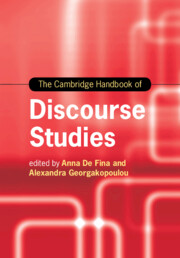Book contents
- The Cambridge Handbook of Discourse Studies
- Cambridge Handbooks in Language and Linguistics
- The Cambridge Handbook of Discourse Studies
- Copyright page
- Contents
- Figures
- Tables
- Contributors
- Preface
- Part I (Con)Textualizing Discourses
- Part II Perspectives and Modes of Analysis
- 6 Sequence Organization: Understanding What Drives Talk
- 7 Doing Micro-Analysis of Discourse: The Case of Ageing and Wellbeing
- 8 Corpus-Assisted Discourse Studies
- 9 Cognitive Linguistic and Experimental Methods in Critical Discourse Studies
- 10 Metaphor, Metonymy and Framing in Discourse
- 11 Poststructuralist Discourse Studies: From Structure to Practice
- Part III Discourse Materialities and Embodiment
- Part IV (Trans)Locations and Intersections
- Part V Ethics, Inequality and Inclusion
- Part VI Discourses, Publics and Mediatization
- Index
- References
8 - Corpus-Assisted Discourse Studies
from Part II - Perspectives and Modes of Analysis
Published online by Cambridge University Press: 28 September 2020
- The Cambridge Handbook of Discourse Studies
- Cambridge Handbooks in Language and Linguistics
- The Cambridge Handbook of Discourse Studies
- Copyright page
- Contents
- Figures
- Tables
- Contributors
- Preface
- Part I (Con)Textualizing Discourses
- Part II Perspectives and Modes of Analysis
- 6 Sequence Organization: Understanding What Drives Talk
- 7 Doing Micro-Analysis of Discourse: The Case of Ageing and Wellbeing
- 8 Corpus-Assisted Discourse Studies
- 9 Cognitive Linguistic and Experimental Methods in Critical Discourse Studies
- 10 Metaphor, Metonymy and Framing in Discourse
- 11 Poststructuralist Discourse Studies: From Structure to Practice
- Part III Discourse Materialities and Embodiment
- Part IV (Trans)Locations and Intersections
- Part V Ethics, Inequality and Inclusion
- Part VI Discourses, Publics and Mediatization
- Index
- References
Summary
This chapter provides practical and theoretical insights into corpus-assisted discourse studies (CADS), an increasingly popular framework for studying language-in-use. By drawing upon both discourse analysis and corpus linguistics, CADS combines methods of text analysis commonly perceived as qualitative and quantitative, respectively. Despite challenges, the main appeal lies in CADS’ ability to reconcile close linguistic analyses with the more broad-ranging analyses made possible by using corpus linguistic methods to analyse language. In addition to providing theoretical insights into CADS, this chapter examines what CADS involves from a practical point of view, e.g. by discussing specific corpus outputs, examples of ways in which qualitative and quantitative approaches to discourse analysis are synergized and triangulated, and the extent to which CADS differs from other kinds of discourse analysis relying on one or more non-corpus-informed approaches in discourse analysis. Interdisciplinary applications in CADS are also considered.
Keywords
- Type
- Chapter
- Information
- The Cambridge Handbook of Discourse Studies , pp. 165 - 185Publisher: Cambridge University PressPrint publication year: 2020
References
Further Reading
This textbook assumes no prior knowledge of corpus linguistics. It is a useful introduction to how corpus tools can be used in discourse analysis.
This is a substantial edited book comprising thirteen independent studies where corpus linguistics and discourse analytic methodologies are practically combined.
This complements the previous two books in that it encourages students and researchers to critically reflect on CADS research.
References
- 10
- Cited by



